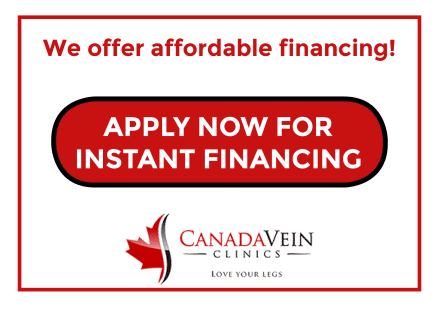Are your varicose veins getting in the way of your life? Understanding varicose veins and treatments is the first step toward knowing whether you should seek medical help. Often, varicose and spider veins can seem harmless. But there are instances where they can be an indicator of underlying health issues or they can become a medical health problem.
If you are living with discomfort or pain caused by varicose veins, you have the right to feel better, look better and live better. Canada Vein Clinics is a state-of-the-art facility providing the latest technological advances in the treatment of varicose veins. Our staff is determined to ensure the most professional and safe care for all of our patients. If you think you may need medical attention for your veins, here are the signs you should look for!
What Are Varicose Veins and Spider Veins?
Varicose veins:
- Are enlarged veins that can be blue, red, or flesh-colored.
- They often look like cords and appear twisted and bulging.
- They can be swollen and raised above the surface of the skin.
- Varicose veins are often found on the thighs, backs of the calves, or the inside of the leg.
Spider veins are like varicose veins but smaller:
- They are closer to the surface of the skin than varicose veins.
- Often, they are red or blue.
- They can look like tree branches or spider webs with their short, jagged lines.
- They can be found on the legs and face and can cover either a small or large area of skin.
What Causes Varicose Veins and Spider Veins?
- Varicose veins can be caused by weak or damaged valves in the veins.
- The heart pumps blood filled with oxygen and nutrients to the whole body through the arteries.
- Veins then carry the blood from the body back to the heart. As your leg muscles squeeze, they push blood back to the heart from your lower body against the flow of gravity.
- Veins have valves that act as one-way flaps to prevent blood from flowing backwards as it moves up your legs.
- If the valves become weak, blood can leak back into the veins and collect there. (This problem is called venous insufficiency.)
- When backed-up blood makes the veins bigger; they can become varicose.
Spider veins can also be caused by the backup of blood.
- They can also be caused by hormone changes, exposure to the sun, and injuries.
What Factors Increase my Risk of Varicose and Spider Veins?
Many factors increase a person’s chances of developing varicose or spider veins. These include:
- Increasing Age – As you get older, the valves in your veins may weaken and not work as well.
- Heredity – Having family members with vein problems also increases your risk. About half of all people who have varicose veins have a family member who has them also.
- Hormonal Changes – These occur during puberty, pregnancy, and menopause. Taking birth control pills and other medicines containing estrogen and progesterone also may contribute to the forming of varicose or spider veins.
- Pregnancy – During pregnancy, there is an increase of blood in the body, this can cause veins to enlarge.
- Obesity – Being overweight or obese can put extra pressure on your veins.
- Lack of Movement – Sitting or standing for a long time may force your veins to work harder to pump blood to your heart.
- Sun exposure – This can cause spider veins on the cheeks or nose of a fair-skinned person.
When to Call a Doctor?
Call your doctor if you have varicose veins and the following symptoms:
- Your leg suddenly becomes swollen and painful. You might have a blood clot in a deep vein, which can be serious and may need prompt attention.
- The skin over a varicose vein begins to bleed on its own or when it is injured. The skin over varicose veins is often thin and can bleed. If this happens, elevate your leg and apply pressure directly to the vein to stop the bleeding.
- Your leg has a tender lump; this could be a clot or inflammation in a vein just under the skin, which is usually not dangerous but may need treatment.
- You develop an open sore (ulcer).
- Your varicose vein symptoms don’t improve with home treatment, or there are symptoms you are concerned about.
What to Expect at Your Appointment
- Initial diagnostic of Varicose Veins – Some people think spider veins are varicose veins, but the distinction is visibly very different.
- Analysis of risk factors that could have caused varicose veins.
- These are daily activities such as prolonged sitting or standing, injuries in the extremities, or pregnancy.
- Treatment options are given – Some non-invasive treatment options like compression stockings might be recommended first before other techniques are implemented.
- Endovenous laser treatment (EVLT) or sclerotherapy can be the next minimally invasive steps to help eliminate varicose veins.
Canada Vein Clinics
The medical staff of the Canada Vein Clinics will ensure the most professional care and safety for all of our patients. We are a state-of-the-art facility providing the latest technological advances in Varicose Veins Treatment.
Throughout your entire Canada Vein Clinics experience, while being treated at Vein Clinic Toronto, Vein Clinic Richmond Hill, Vein Clinic Halifax or Vein Clinic Lindsay, you will be under the care of one CVC physician. This ensures consistency and accuracy – from diagnosis to treatment, and in follow-up care. It also guarantees your personal ease and comfort.
Schedule Your Assessment!
The Maritime’s first and foremost provider of treatment and diagnosis of vein disease call us at (888) 876-8346.

